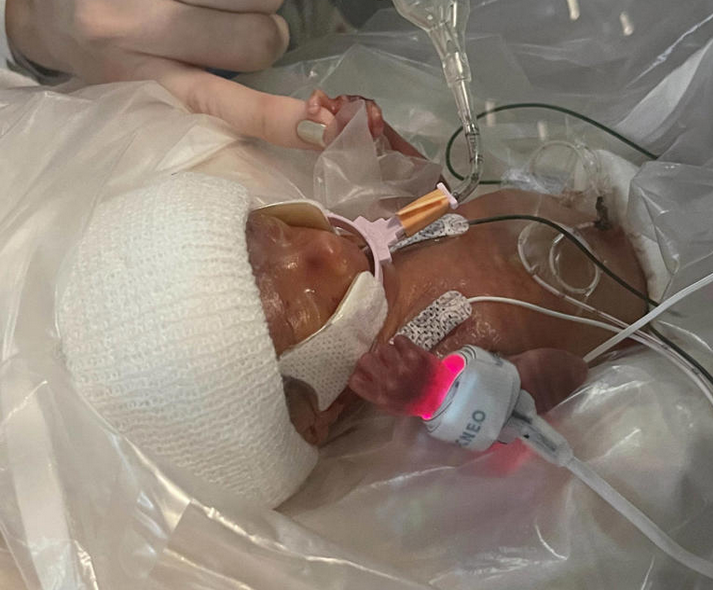Yahoo News featured the story of a child born at 22 weeks who is now a toddler. Tuff Born, son of Michaela and Jake Born, was born at 22 weeks and one day.
A Survivor Born at 22 Weeks
In the interview for Yahoo News, Michaela said that doctors told her he son would be seriously disabled and have no “quality of life.” She says, “[A]t one point, they told us if he did survive, he’d probably be plugged into a wall and have oxygen, and then basically no quality of life.”
However, at two years old, Tuff has no serious health problems.
Follow LifeNews.com on Instagram for pro-life pictures and videos.
Though reporter Rosie Colosi admits “Tuff may still be working on some milestones,” she says that when he visited the NICU, where he spent 136 days, he was “running around just like any other 2-year-old.”
Michaela described Tuff as “full of energy and just babbling non stop.”
When Tuff was born, he wasn’t breathing. It took three attempts to resuscitate him. Colosi points out that if Tuff had been born just a day earlier, he might not have been resuscitated at all:
If Michaela and Jake Born’s feisty 2-year-old son had been born 24 hours earlier, he likely would not have survived.
Most hospitals will not attempt to resuscitate a baby born at 22 weeks gestation…
More and More 22-Week Babies are Surviving
A recent study (April 2025) found that practices on treating babies born at 22 weeks vary widely across hospitals, but that when these babies are treated, up to two out of five survive. And the number of survivors is increasing.
“Survival Trends for Periviable Births” in the Journal of the American Medical Association documented treatment and survival rates for preemies born between 2014 and 2024.
It found that the number of 22-week preemies treated has increased over the years. During the range of time studied, active treatment rates ranged from 28.8% to 78.6%.
Survival rates among babies who were treated ranged from 25.7% to 41.%. They are also on the rise.
For 23-week infants, treatment rates were 87.4% to 94.7%, and 53.8% to 57.9% of those treated babies survived. Over half.
These were the rates of survival for babies who received medical care. Unfortunately, most sources only give statistics for all babies born at these ages. When you group babies who are treated with babies who are not treated, then, of course, the survival rate goes down significantly.
The vast majority of children born at 22 weeks and not given medical care die. So the widely shared statistics are often misleading.
The study also found a “small increase” in rates of treatment for children born at 24 weeks. Survival rates among children born at 24 weeks and treated were the same as in earlier studies.
Surprisingly, Black infants were more likely than White infants to receive active treatment at 22 and 23 weeks. Perhaps more Black women argue for their babies to be treated, or perhaps women of color are more likely to give birth at hospitals that regularly treat young preemies. The reasons weren’t made clear in the study, so we can only guess.
The study said:
This shift [in treatment rates] can be attributed to advancements in medical technology, updated clinical guidelines, and publications highlighting differences in hospital practices for initiating active treatment and variation in outcomes. These factors have collectively shifted the limit of viability.
One would think this study was mainly good news. However, the authors manage to make pro-abortion comments and even bash pro-life laws:
Monitoring the rate of active treatment at periviable gestations is particularly important due to increases in fertility associated with restrictive abortion policies enacted in many states since 2021.
Neonatologists may feel ethically or legally obligated to attempt to provide life support, regardless of prognosis.
The publication this study appeared in, The Journal of the American Medical Association, has a long history of publishing pro-abortion editorials. It also publishes many purportedly pro-abortion studies, some of which have major methodological flaws.
So, the pro-abortion rhetoric at the end of the study doesn’t really surprise me.
According to the Charlotte Lozier Institute, there are 159 abortion centers and hospitals in the United States that are known to perform abortions at or after 21 weeks of gestation.
LifeNews Note: Sarah Terzo covered the abortion issue for over 13 years as a professional journalist. In this capacity, she has written nearly a thousand articles about abortion and read over 850 books on the topic. She has been researching and writing about abortion since attending The College of New Jersey (class of 1997) where she minored in Women’s Studies. This article originally appeared on Sarah Terzo’s Substack. You can read more of her articles here.











